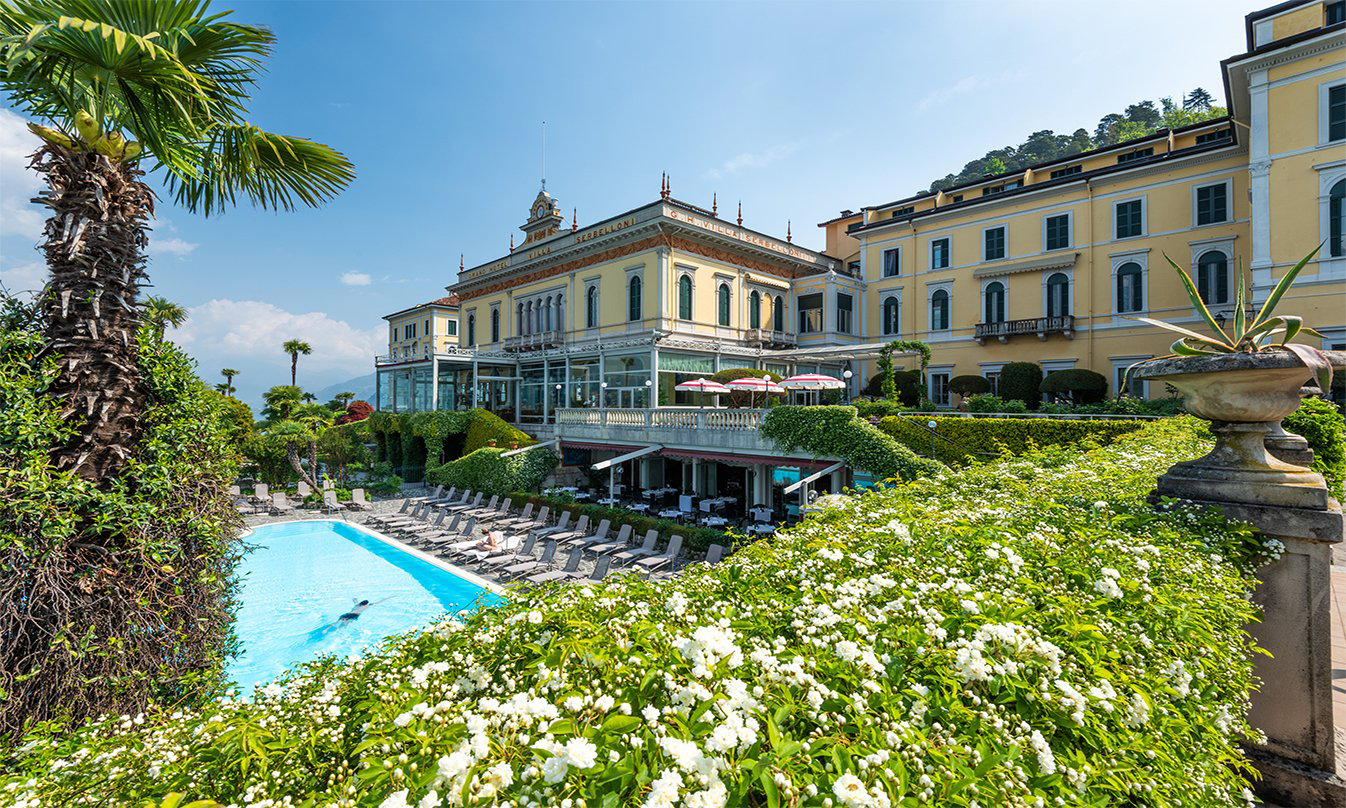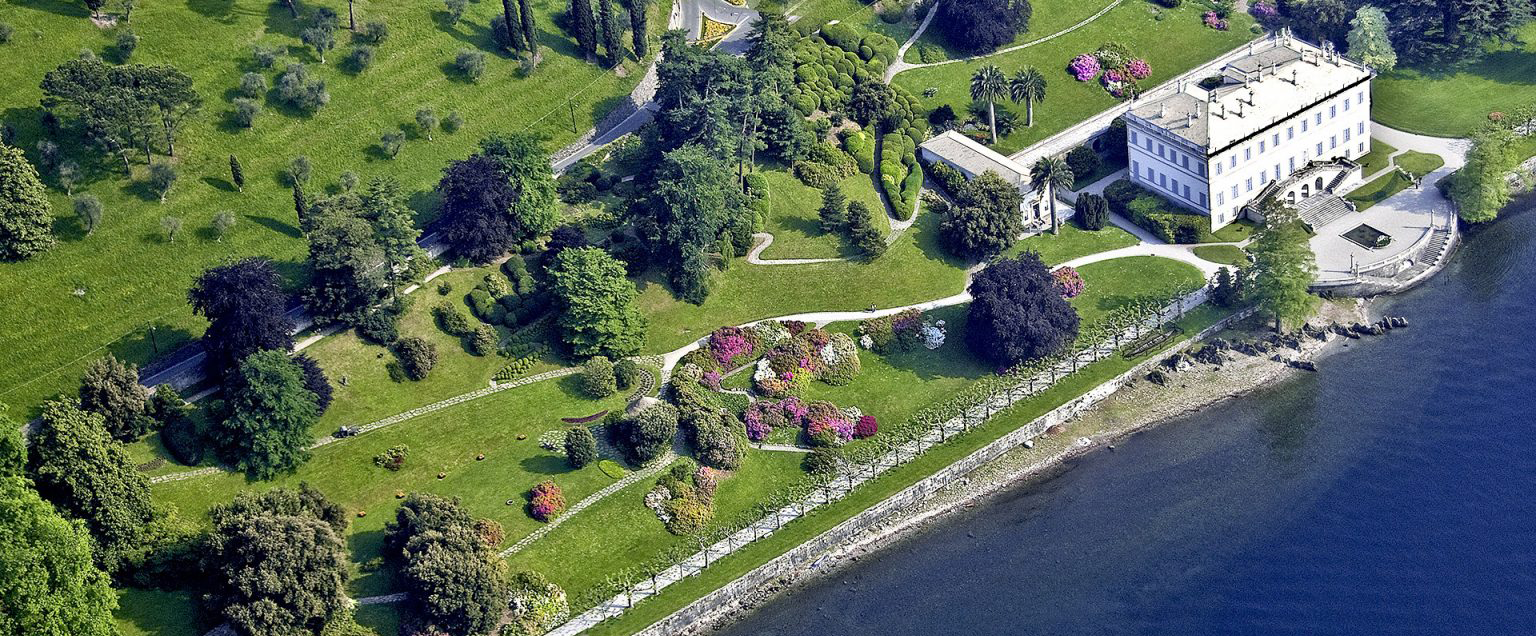A walk along the streets of Bellagio
Getting off the ferry or from the boat turn left and proceed along the arcades with shops and restaurants until you reach the entrance of the Grand Hotel Villa Serbelloni, which was built as a Private Home for the family Fimozzi in 1852. It was converted into a hotel in 1872, with the name of the Grand Hotel Bellagio, and, after having acquired the historic Villa Serbelloni, it took its name.

Having passed the entrance of the Hotel Villa Serbelloni, turn left and you arrive at Punta Spartivento, the extreme tip of the peninsula, where the lake divides into two branches, and where you can enjoy a magnificent panorama on the most extensive part of the lake of Como.
You return along the same stretch of road, but when you arrive at the junction, proceed straight and you enter into the high part of the village, until you reach the Basilica of San Giacomo.
The Church, declared a National monument in 1904, is an example of Lombard- Romanesque architecture. The building dates back between the end of the XI and the beginning of the XII century.
The lower part of the bell tower shows to be previous of the church, and it is believed to be one of the signalling towers of the ancient defensive system: towers that are still scattered along the lake since the Romans’ times.
Around the end of the year 1000 against the bell was built the medieval church and, at the same time, it was transformed into a bell tower; but it was in the 18th century that the bell tower was raised to the present shape.
Next to the Basilica it opens to a large square enclosed by more or less ancient buildings; the Sports Bar was once a Monastery.
Turning your back to the Sports Bar, at the bottom of the square, at the right, you can admire a Medieval Tower, the last reminder of the medieval defensive system. Today the tower is used as seat of cultural events and art exhibitions.
Looking upwards you can see a small portion of the historic Villa Serbelloni that in 1959, was purchased by the Rockefeller Foundation of New York and since then it has become the seat of studies and international conferences.
The gardens of the villa can be visited daily with guided tours (except on Mondays and in case of bad weather) with departure from the outside apses of the Basilica.
In the middle of the square you can admire a beautiful fountain in granite, built in 1897, on account of Mr. Pical for celebrating the 60th anniversary of reign of the Empress Victoria of Great Britain.
Originally, the fountain was placed in the park of Villa Gotica, ( a building which was originally to be an Anglican Church), but was transported to its current location between 1908 and 1910.
It was modified in 1949, when, to celebrate the passage in Bellagio of the Statue of Our Lady Pilgrim, the fountain was deprived of the Great Star and in its place was placed the statue of the Madonna with Child.
Back along the Via Garibaldi that runs through the upper part of the Village of Bellagio, along which there are shops and craft shops of every kind, and from which branch off the stairs that descend towards the lake.
Almost at the end of Via Garibaldi you meet at your right a wide staircase with shops called Salita Serbelloni, which the inhabitants of Bellagio call The Moat in memory of the Medieval Vallum (ditch) dug for the defence of the Village.
In fact, the wall at your right was part of the Walls with three gates to enter the Village and the Drawbridge was located right at the entrance of the Salita Serbelloni.
Carrying on straight, you come to an elegant building, today seat of the town Hall, with a fresco of the Coat of arms of the Town of Bellagio. Next to it there is the church dedicated to San Giorgio, built in the XI - XII century, coeval with the Basilica of San Giacomo.
The apse and the altar were originally facing east, but were later moved to the current location and the new entrance was opened to the street.
The location of the bell-tower is unique for it is located astride of the (Climb) Salita Genazzini. (Passing under the bell tower to the right you come to the Municipal Library, built in 1914 in art nouveau style by the sons of Domenico Vitale to whom it is dedicated).
Before going down following the road that winds down towards the lake, you can cross the wide Municipal Park, and to your right, you can see the Villa Gotica, a mansion built in neo-gothic style towards the end of the 19th century, which originally was meant to be an Anglican Church, but which towards the middle of the 20th century was converted into an apartments house.
Toward the bottom of the Park, at your left hand side you’ll notice a tower that once contained a mechanism moved by water, which lifted the elevator inside the Hotel Great Britain, which was also the home of the prestigious hotel school in Bellagio.
Going down to the along the lake road, you reach a junction where;
• turning to the left you can reach the splendid park of Villa Melzi, which is open to the public from March to the beginning of November, with continuous hours from 9.00 to 18.30 every day.
• turning to the right you head towards the along lake promenade of Bellagio and you’ll arrive at a little square with the ferry boat landing station.

On the facade of the Hotel Splendid is located a memorial plaque in memory of Filippo Tommaso Marinetti, poet and creator of the artistic current of Futurism, who died in that building in 1944.
Proceed straight ahead, a little farther on, at the beginning of the Salita Serbelloni, to the right, you meet another plate put into the wall of a house in 1961, to celebrate the 150° anniversary of Franz Liszt’s birthday (1811 – 1886), , as a reminder of the months the great Hungarian musician spent at the Bellagio in !837, as a Guest of Count Melzi.
You then will meet a pass-under Portico, which was one of the ancient gates to the Fortified Medieval Village, and you’ll find yourself at Piazza Mazzini, where to your left you will see the hotel Mètropole, the very first hotel of Bellagio opened to the public in 1825.
Here ends the Tour of Bellagio, near the pier for the boats; if you want to take the car ferry, you have to go back a few hundred meters.